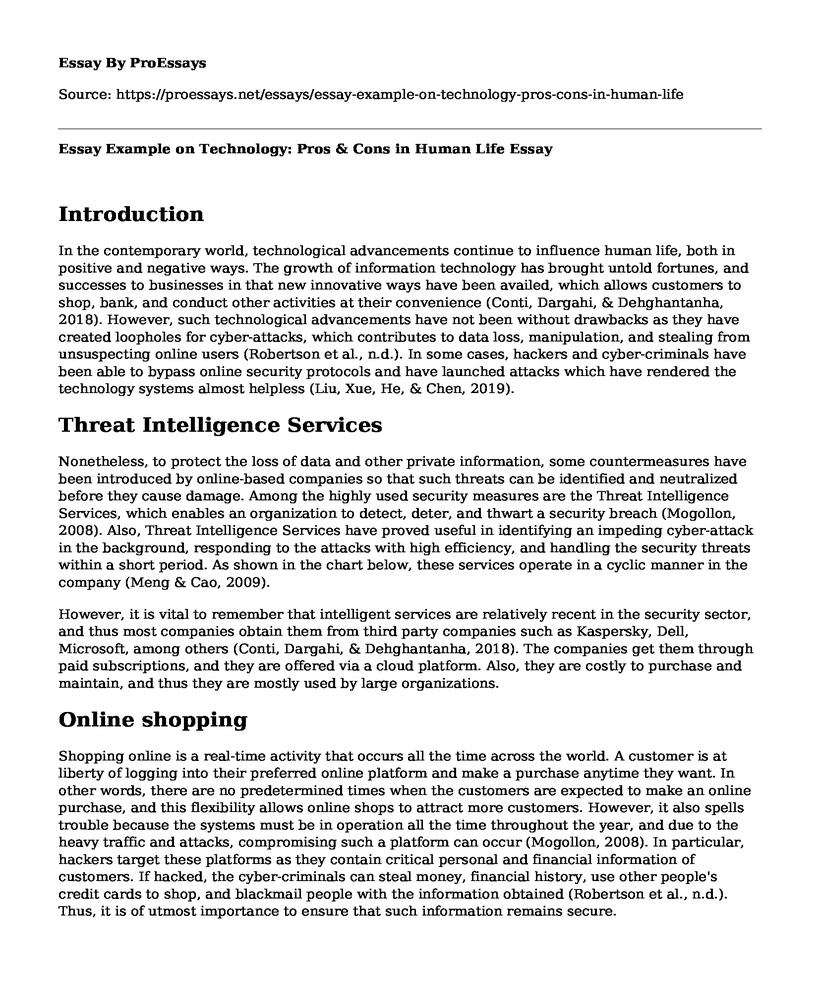Introduction
In the contemporary world, technological advancements continue to influence human life, both in positive and negative ways. The growth of information technology has brought untold fortunes, and successes to businesses in that new innovative ways have been availed, which allows customers to shop, bank, and conduct other activities at their convenience (Conti, Dargahi, & Dehghantanha, 2018). However, such technological advancements have not been without drawbacks as they have created loopholes for cyber-attacks, which contributes to data loss, manipulation, and stealing from unsuspecting online users (Robertson et al., n.d.). In some cases, hackers and cyber-criminals have been able to bypass online security protocols and have launched attacks which have rendered the technology systems almost helpless (Liu, Xue, He, & Chen, 2019).
Threat Intelligence Services
Nonetheless, to protect the loss of data and other private information, some countermeasures have been introduced by online-based companies so that such threats can be identified and neutralized before they cause damage. Among the highly used security measures are the Threat Intelligence Services, which enables an organization to detect, deter, and thwart a security breach (Mogollon, 2008). Also, Threat Intelligence Services have proved useful in identifying an impeding cyber-attack in the background, responding to the attacks with high efficiency, and handling the security threats within a short period. As shown in the chart below, these services operate in a cyclic manner in the company (Meng & Cao, 2009).
However, it is vital to remember that intelligent services are relatively recent in the security sector, and thus most companies obtain them from third party companies such as Kaspersky, Dell, Microsoft, among others (Conti, Dargahi, & Dehghantanha, 2018). The companies get them through paid subscriptions, and they are offered via a cloud platform. Also, they are costly to purchase and maintain, and thus they are mostly used by large organizations.
Online shopping
Shopping online is a real-time activity that occurs all the time across the world. A customer is at liberty of logging into their preferred online platform and make a purchase anytime they want. In other words, there are no predetermined times when the customers are expected to make an online purchase, and this flexibility allows online shops to attract more customers. However, it also spells trouble because the systems must be in operation all the time throughout the year, and due to the heavy traffic and attacks, compromising such a platform can occur (Mogollon, 2008). In particular, hackers target these platforms as they contain critical personal and financial information of customers. If hacked, the cyber-criminals can steal money, financial history, use other people's credit cards to shop, and blackmail people with the information obtained (Robertson et al., n.d.). Thus, it is of utmost importance to ensure that such information remains secure.
Threat Intelligence platform
To ensure that cyber-criminals are kept out, the use of threat intelligence services becomes paramount. By using these services, companies can analyze, collect, and filter crucial data about various online threats. After detecting the dangers, a message is relayed to automated security control systems in a manner of data feeds, an also it compiles a security report to the company (Robertson et al., n.d.). Threat Intelligence service can handle advanced attacks and common malware such as Trojan horses and viruses. By its use, threat intelligence services can improve the efficiency of the online security department in an organization as highlighted in the figure shown below created by Micro-Soft VISIO (Liu, Xue, He, & Chen, 2019).
Security Information management
From the figure above, it is evident that the intelligence of a possible impending attack is detected from the threat feed and security analytics. Once the data is analyzed at the information processing platform, it is further broken down into three distinct categories which are strategic threats, operational or tactical (Liu, Xue, He, & Chen, 2019). When the type of attack is determined, it becomes easy to intercept it.
Conclusion
In conclusion, as attackers get advanced in terms of technological use, so must small and big online companies embrace advanced defense mechanism to prevent the loss of vital information. By using, Threat Intelligence Services in an organization, it is possible to ensure that the systems are secure and that the safety of customers is guaranteed.
References
Conti, M., Dargahi, T., & Dehghantanha, A. (2018). Cyber Threat Intelligence: Challenges and Opportunities. Advances in Information Security, 1-6. doi:10.1007/978-3-319-73951-9_1
Liu, M., Xue, Z., He, X., & Chen, J. (2019). Cyberthreat-Intelligence Information Sharing: Enhancing Collaborative Security. IEEE Consumer Electronics Magazine, 8(3), 17-22. doi:10.1109/mce.2019.2892220
Meng, X., & Cao, Y. (2009). Analysis and Countermeasures of China's Network Marketing. International Journal of Marketing Studies, 1(1). doi:10.5539/ijms.v1n1p58
Mogollon, M. (2008). Information Assurance. Cryptography and Security Services, 15-32. doi:10.4018/978-1-59904-837-6.ch002
Robertson, J., Diab, A., Marin, E., Nunes, E., Paliath, V., Shakarian, J., & Shakarian, P. (n.d.). Moving to Proactive Cyber Threat Intelligence. Darkweb Cyber Threat Intelligence Mining, 4-12. doi:10.1017/9781316888513.004
Cite this page
Essay Example on Technology: Pros & Cons in Human Life. (2023, Feb 12). Retrieved from https://proessays.net/essays/essay-example-on-technology-pros-cons-in-human-life
If you are the original author of this essay and no longer wish to have it published on the ProEssays website, please click below to request its removal:
- Essay Example on Social Issue - The Effect of Divorce for Young Generation
- Essay on Use of Kinesics in People's Interaction
- Essay Sample on Effects of Social Media to the Society
- Research Paper on Artificial Intelligence in Healthcare
- Expert Systems: AI Technologies for Human/Organizational Behaviors - Essay Sample
- Essay Sample on Fossil Fuel Energy: Global Impact, Concerns & Solutions
- Essay Sample on Parental Surveillance: Protecting Children or Violating Privacy







